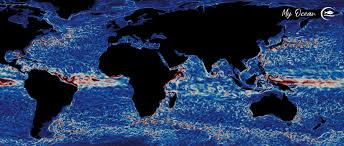Study Reveals Acceleration of Upper-Ocean Circulation in the Equatorial Pacific

A recent study published on October 31, 2024, in the *Journal of Geophysical Research: Oceans* has uncovered a significant acceleration in the upper-ocean circulation of the equatorial Pacific over the last 30 years. This acceleration, primarily attributed to intensified atmospheric winds, has resulted in stronger and shallower oceanic currents, which may affect both regional and global climate patterns, including the frequency and intensity of El Niño and La Niña events.
Led by Franz Philip Tuchen, a postdoctoral scientist at the University of Miami's Rosenstiel School's NOAA Cooperative Institute for Marine and Atmospheric Studies (CIMAS), the research team collaborated with NOAA's Atlantic Oceanographic and Meteorological Laboratory (AOML) to synthesize three decades of ocean and atmosphere observations. They utilized data from satellites, mooring buoys, and ocean surface drifters to create a comprehensive view of changes in the Pacific upper-ocean circulation.
The study indicates that stronger winds across the equatorial Pacific have accelerated westward near-surface currents by approximately 20 percent in the central equatorial Pacific. Additionally, poleward currents north and south of the equator have increased by 60 percent and 20 percent, respectively. Tuchen noted that the equatorial thermocline, a crucial ocean layer for El Niño-Southern Oscillation (ENSO) dynamics, has steepened significantly. "This steepening trend could reduce ENSO amplitude in the eastern Pacific and favor more frequent central Pacific El Niño events," he explained, indicating potential alterations to regional and global climate patterns.
This study provides a benchmark for climate models that have struggled to accurately represent Pacific circulation and sea surface temperature trends. The findings could enhance the predictability of ENSO events and their associated weather patterns, especially in regions like the United States that experience significant climate variability from these changes. Funding for this research was provided by NOAA's Global Ocean Monitoring and Observing (GOMO) programs, including the Global Tropical Moored Buoy Array (GTMBA), the Global Drifter Program (GDP), and the Tropical Atmosphere Ocean (TAO) program.
Story Source:
Materials provided by University of Miami Rosenstiel School of Marine, Atmospheric, and Earth Science. The original text of this story is licensed under a Creative Commons License. Note: Content may be edited for style and length.
Journal Reference:
- Franz Philip Tuchen, Renellys C. Perez, Gregory R. Foltz, Michael J. McPhaden, Rick Lumpkin. Strengthening of the Equatorial Pacific Upper‐Ocean Circulation Over the Past Three Decades. Journal of Geophysical Research: Oceans, 2024; 129 (11) DOI: 10.1029/2024JC021343

0 Comments